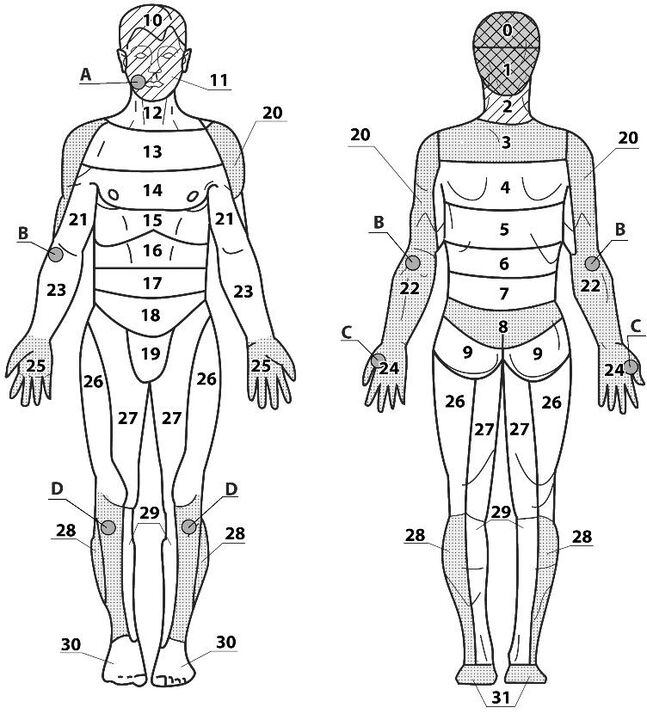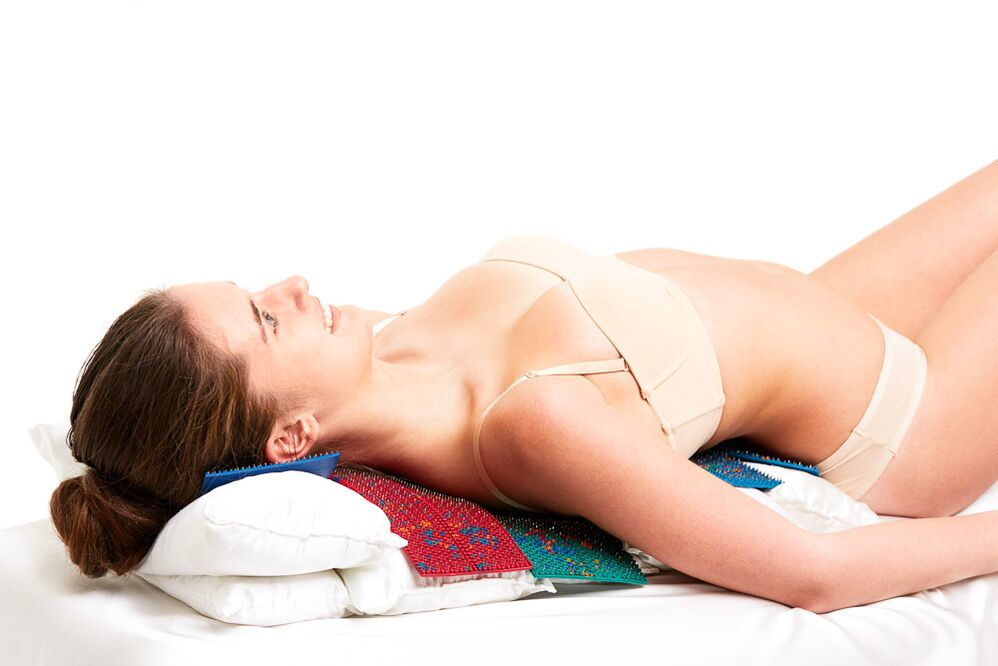Cervical osteochondrosis is a progressive dystrophic-degenerative damage to the intervertebral discs in the area of 1-7 vertebrae belonging to the cervical vertebrae.
Cervical osteochondrosis results in deformity, exhaustion and then damage to the vertebral bodies. This disrupts the normal blood supply and nerve conduction of the neck and in those areas that are innervated by the nerve roots of the cervical spine.
Cervical osteochondrosis can be isolated or combined with osteochondrosis of other parts - thoracic, lumbar and sacral.
Reasons
There are a number of factors that predispose to the development of osteochondrosis. They include:
- sedentary and sedentary lifestyle;
- sedentary types of work with static load on the neck;
- overweight, insufficient physical development;
- connective tissue dysplastic processes;
- circulatory disorders in the neck;
- neck injuries;
- scoliosis, poor posture, uncomfortable pillows and mattresses;
- hereditary predisposition, metabolic defects.
Symptoms of cervical osteochondrosis. Complications
The cervical spine is most vulnerable to the development of osteochondrosis. The vertebrae in it are the smallest compared to other parts of the spine, the muscular frame is not very pronounced, the weight of the head and the upright posture act on the vertebrae. In the cervical spine, the vertebrae fit snugly together. Even a minimal change in them can lead to compression and even displacement of nerves and blood vessels.
The most characteristic symptom that patients complain of is pain in the cervical spine. Depending on the affected area, the pain can be localized: in the clavicle and shoulder; all over the cervical vertebra; on the anterior surface of the thorax.
The first signs of cervical osteochondrosis may be minor: a feeling of heaviness in the head, headache in the occipital region, neck pain in the evening, tingling or numbness in the shoulders and arms.
Leading symptoms
Vegetative-dystonic.
Severe "shooting" pain in the neck, in the area just below the back. The pain occurs after a long stay in one position, after sleep, constant tension in the muscles of the neck.
Difficulty moving the arm to the side, stiffness, numbness of the fingers. Due to compression of the vertebral arteries, neurological manifestations are observed: headache, nausea, dizziness, unjustified jumps in blood pressure.
Spinal symptom.
The pain is localized behind the left sternum.
This type of pain should be different from the pain of angina (in angina pectoris nitroglycerin brings relief, in osteochondrosis not).
With the gradual disruption of the structure of the intervertebral discs, they are compressed and there is a violation of the nerve roots, as well as narrowing or disruption of the arteries and veins that pass in the area of the vertebral bodies.
This leads to the formation of special syndromes - radicular and ischemic:
- lesion of the roots of the first cervical vertebra (C1): abnormalities in the occipital region;
- The C2 lesion causes pain in the area of the crown and occiput;
- the lesion of C3 gives pain in the neck on the side of the disorder, decreased sensitivity of the tongue and hypoglossal muscles, speech impairment is possible;
- damage to C4 and C5 gives pain in the shoulder and clavicle, decreased tone of the muscles of the head and neck, hiccups, respiratory disorders and heart pain;
- Lesion C6 is the most common, gives pain from the neck to the shoulder blade, forearm, to the thumbs, skin sensitivity may suffer;
- C7 lesion - similar symptoms with pain in the neck, back of the shoulder, to the back of the arm, impaired arm strength and decreased reflexes.
Circulatory disorders due to compression of blood vessels in the cervical spine can lead to headaches, migraines, dizziness, impaired vision and tinnitus, blinking flies in front of the eyes, impaired autonomic function.
There may be manifestations of cardiac syndrome with pressing pain in the heart, shortness of breath and palpitations, arrhythmias.
Complications.
Protrusion of the intervertebral discs with the formation of a hernia (bulge).
Rupture of the intervertebral disc with pinching of nerves and blood vessels, possible compression of the spinal cord, which can be fatal.
Root lesions (radiculopathy), formation of spines on the bodies of the vertebrae (osteophytes) with the manifestation of paresis and paralysis.
In the presence of the above complaints it is necessary to contact an orthopedist or neurologist and conduct the necessary tests.
Nutrition
Proper nutrition will significantly alleviate the condition with osteochondrosis. Nutrition should be complete. If a person has a normal body weight, then as a basis you can take therapeutic diet number 15 according to Pevzner. It contains all the necessary minerals and an increased amount of fat and water-soluble vitamins. It is necessary to eat foods high in natural chondroprotectors. Chondroitin is found in red fish, animal tendons and cartilage, and chicken.
Do not forget to take clean water in a volume of 1, 5-2 liters. Fluid is needed to prevent the intervertebral discs from drying out.
Traditional and non-traditional treatments
Treatment
Today, there are both traditional and non-traditional methods for treating osteochondrosis of the cervical spine.
Drug treatments: symptomatic therapy with analgesics to relieve pain; taking nonsteroidal anti-inflammatory drugs to relieve inflammation and tissue swelling; antispasmodics; drugs to improve blood circulation; chondroprotectors to restore the structure of the intervertebral discs.
A course of therapy with vitamin B, external means of therapy - gels and ointments, creams with anti-inflammatory, warming and analgesic components are shown.
During the period of exacerbation it is recommended to wear a special collar (Shants collar).
Complications of cervical osteochondrosis with intervertebral hernias that impair sensitivity and circulation can be treated immediately.
The duration of treatment depends on the neglect of the condition, as osteochondrosis is a progressive chronic disease. The treatment can be long and the preventive courses can last a lifetime.
Physiotherapeutic treatments.
These include exercise therapy, magnetic therapy, balneotherapy, laser therapy, acupuncture, Lyapko application therapy and massage.
Physiotherapy
It is mandatory to do exercises to treat cervical osteochondrosis several times a day every day. These include self-stretching, self-massage, a set of special exercises. Avoid neck injuries and lifting weights.
It is necessary to combine prolonged sitting with periods of rest and warm-up.
The basis of the health of the cervical spine is a healthy and healthy back, physical activity, a comfortable bed with anatomical pillows and a mattress, proper posture and proper nutrition.
Therapy with Lyapko application

Areas of application:
- basic 2, 3;
- additional 1, 4, 12, 13;
- auxiliary 20, 22, 28, 31.
General recommendations
When using the applicator, the main, additional and maximum pain area are used, but for severe pain, applicators should be applied above and below the painful area or points and areas on the opposite side should be used. Exposure time 10-30 minutes.

If cervical osteochondrosis is combined with osteochondrosis of other parts - thoracic, lumbar and sacral, then the application therapy can be applied simultaneously or in turn to all parts of the spine. The larger the exposure area, the better the effect.















































